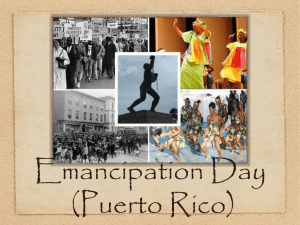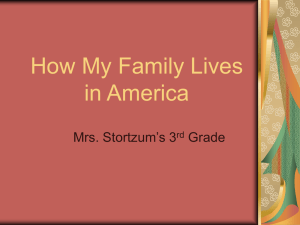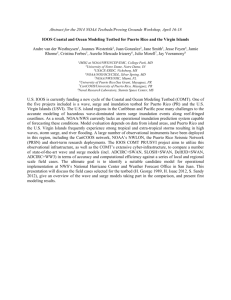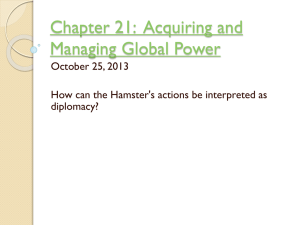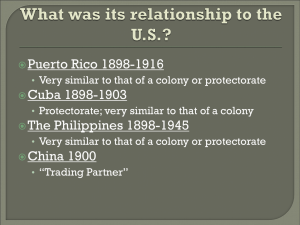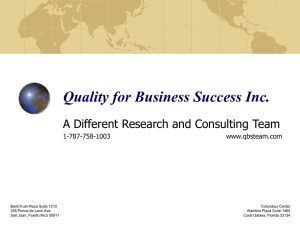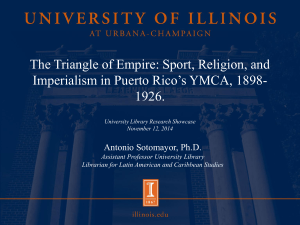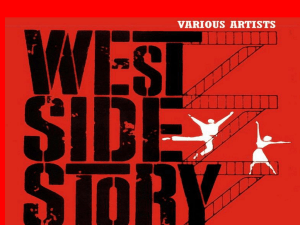Conflict Theories Final
advertisement
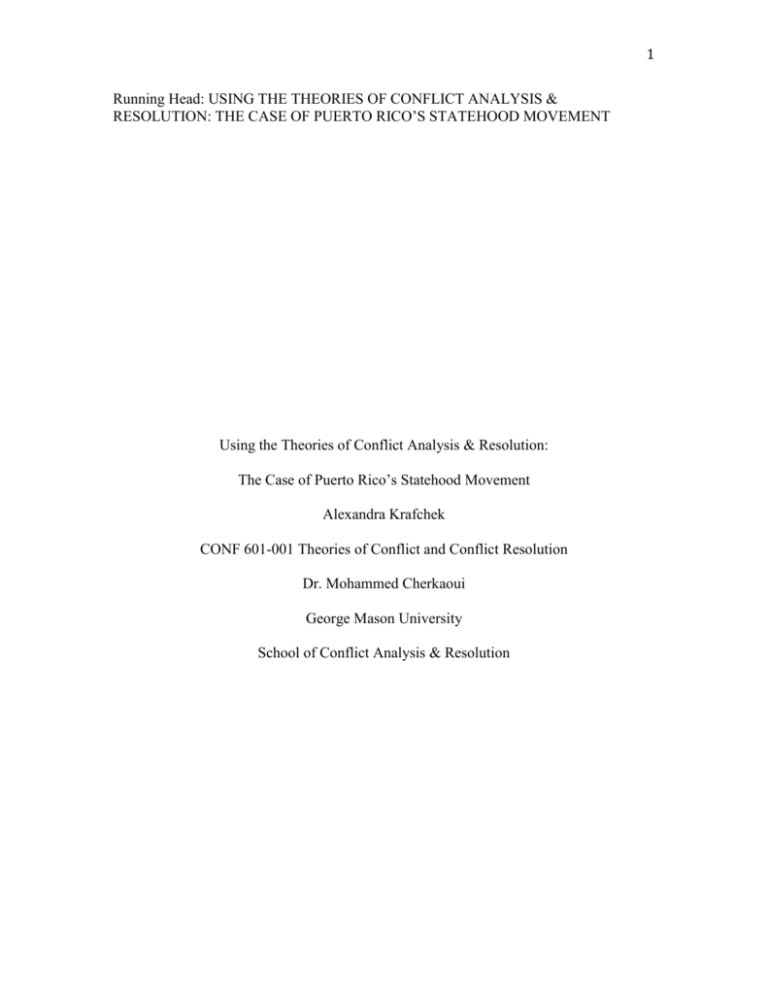
1 Running Head: USING THE THEORIES OF CONFLICT ANALYSIS & RESOLUTION: THE CASE OF PUERTO RICO’S STATEHOOD MOVEMENT Using the Theories of Conflict Analysis & Resolution: The Case of Puerto Rico’s Statehood Movement Alexandra Krafchek CONF 601-001 Theories of Conflict and Conflict Resolution Dr. Mohammed Cherkaoui George Mason University School of Conflict Analysis & Resolution USING THE THEORIES OF CONFLICT ANALYSIS & RESOLUTION: THE CASE OF PUERTO RICO’S STATEHOOD MOVEMENT 2 Introduction Since 1898 Puerto Rico has been an unincorporated United States (U.S.) territory (Shoichet, 2012). Although Puerto Ricans are Untied States citizens they cannot vote for the president, they have a nonvoting representative in Congress, are subject to federal laws but are exempt from some federal taxes (Shoichet, 2012). In a controversial decision, on November 6th, 2012, 61% of Puerto Rican’s voted for Puerto Rico to become a U.S. state (Shoichet, 2012). This nonbinding referendum has reinvigorated this ongoing statehood movement. The field of Conflict Resolution is multidisciplinary in nature, deriving theories from sociology, political science, psychology, economics, international relations, and many others. This paper will use several theories from these fields, including social mobilization, functionalism, realism, Marxism, basic human needs theory, relative deprivation, cultural theory and social identity theory in order to analyze the recent protests and movement surrounding Puerto Rico statehood, and make recommendations for the resolution of the conflict. A very brief background of the conflict is first presented as a foundation for the analysis. Background The debate on the status of Puerto Rico’s statehood has lasted for decades (Miller, 2012). The previous referendums on the issue of Puerto Rico’s statehood were held in 1967, 1993 and 1998 (Miller, 2012). In the most recent referendum two questions were asked (Jefferson, 2012). In the first, 54 percent answered that they were dissatisfied with the relationship between the United States and Puerto Rico (Jefferson, 2012). In the second question voters were asked if they wanted to become a state of the United States, an independent country, or a freely associated state (Jefferson, 2012) with 61 percent USING THE THEORIES OF CONFLICT ANALYSIS & RESOLUTION: THE CASE OF PUERTO RICO’S STATEHOOD MOVEMENT 3 voting for statehood (Jefferson, 2012). However, 460,000 people intentionally left the second question blank (Jefferson, 2012), perhaps protesting the lack of a fourth option, to keep the current relationship with the United States as is (Jefferson, 2012). Or it may bet due to the confusing wording of the question, which pushed the vote in favor of statehood. Nevertheless, the movement has gain momentum following the referendum (Jefferson, 2012). Congressional action would be needed to change the current status however (Shoichet, 2012). The recent response from the White House was that the results of the recent referendum were unclear, and thus, so is their status (Miller, 2012). In the same election, current governor Luis Fortuno, who supported statehood, was defeated by Alejandro Paadilla, who supports the current relationship with the U.S. (Costantini, 2012). A recent economic downturn and diminishing population due to Puerto Ricans moving to the mainland of the U.S. have led to the recent push for statehood (Shoichet, 2012). Unemployment in Puerto Rico is nearly double the rate of the U.S. at 13.5 percent and the per capita income ($15, 203) is less than half of the poorest state in the United States (Pringle, 2012). Due to this high poverty, many Puerto Ricans have left Puerto Rico to live on the mainland in search of greater economic opportunities (Shoichet, 2012). In 2010, 4.6 million Puerto Ricans lived in the U.S. while only 3.7 lived in Puerto Rico (Pringle, 2012). Furthermore, Puerto Rico experiences “brain drain” in that Puerto Rican professional such as doctors, can earn more income on the mainland than in Puerto Rico so they set up their practice there instead (Pringle, 2012). USING THE THEORIES OF CONFLICT ANALYSIS & RESOLUTION: THE CASE OF PUERTO RICO’S STATEHOOD MOVEMENT 4 Many believe the tax benefits given to United States corporations who invest and set up their industry in Puerto Rico have caused much of the economic downturn in Puerto Rico (Pringle, 2012). The profits are rarely reinvested back into the country and because of this, the territory is becoming increasingly dependent on the United States government for aid (Pringle, 2012). In addition, the rate of drug trafficking and violent crime has increased in recent years as the economy deteriorates (Pringle, 2012). Furthermore, the education system is deeply flawed and in need of improvement to help boost the economy long term (Pringle, 2012). In the past few years, protests about tuition spikes for education have flourished, with some becoming violent between police and protesters (Rodriquez, 2011). Theoretical Analysis As previously mentioned, the field of conflict analysis and resolution is multidisciplinary in nature and scope. The dynamic nature of conflict makes adhering to only one theory ineffective. A practitioner that fails to take multiple theories and perspective into account when analyzing a conflict has little hope in a resolution. For this reason a holistic analysis of the conflict of Puerto Rico’s statehood is presented using the theories of social movements, functionalism, realism, Marxism, basic human needs theory, relative deprivation, cultural theory and social identity theory. First is the theory of social movements. Tarrow defines a social movement as, “when contention spreads across an entire society, as it sometimes does, we see a cycle of contention; when such a cycle is organized around opposed or multiple sovereignties, the outcome is a revolution” (Tarrow, 1998). Although the definition is a bit extreme in nature, I think the idea behind it is applicable to the case of Puerto Rico. Contention has USING THE THEORIES OF CONFLICT ANALYSIS & RESOLUTION: THE CASE OF PUERTO RICO’S STATEHOOD MOVEMENT 5 been spreading across the territory for decades and although it has not yet reached the point of a revolution, that is not to say that it won’t due so in the future. The social movement towards the statehood of Puerto Rican has been gaining momentum for decades. In the past few years, protests surrounding jobs, the economy and education have sparked a boost in this momentum, ultimately leading to the recent referendum. Tarrow explains the problem of political opportunities and constraints that lead people to mobilize, in summary, Contentious politics is produced when political opportunities broaden, when they demonstrate the potential for alliances, and when they reveal the opponents’ vulnerability. Contention crystallizes into a social movement when it taps embedded social networks and connective structures and produces collective action frames and supportive identities able to sustain contention with powerful opponents. By mounting familiar forms of contention, movements become focal points that transform external opportunities into resources. Repertoires of contention, social networks, and cultural frames lower the costs of bringing people into collective action, induce confidence that they are not alone, and give broader meaning to their claims. Together these factors trigger the dynamic processes that have made social movements historically central to political and social change (Tarrow, 1998, p. 23). The social movement in Puerto Rico is attempting to broaden the political opportunities by gaining statehood status. In doing so they would have more political input in the country because, for example, they would be able to vote for the president and have a voting representative in Congress. The social and identity theories discussed later help to USING THE THEORIES OF CONFLICT ANALYSIS & RESOLUTION: THE CASE OF PUERTO RICO’S STATEHOOD MOVEMENT 6 explain the mobilization of the Puerto Rican population. By essentially decolonizing the territory of Puerto Rico, the movement towards statehood could lead to economic and political social transformation. As a social movement, the Puerto Rico conflict has a purpose and function (Coser, 1956). From a functionalist perspective, conflict is not a “social disease” and can be a tool for social change (Coser, 1956). To the functionalist, the difference between hostile attitudes and conflict is that the later has the potential to change relationships and structure (Coser, 1956). Coser writes, “conflicts which arise from frustration of specific demands within the relationship and from estimates of gains of the participants, and which are directed at the presumed frustrating object, can be called realistic conflicts, insofar as they are means toward a specific result” (Coser, 1956, p. 50). The conflict over Puerto Rican statehood would be considered a realistic conflict since it is a means to an end (Coser, 1956). The protests about the lack of political status for Puerto Rico and the recent referendum serve a function for the territory, with the end goal being statehood. As part of the functionalist argument, the idea of a modern safety valve emerges as a way of channeling negative energies and hostilities (Coser, 1956). Often times this is a minor act of resistance allowed by those with power (Coser, 1956). In fact, “conflict serves as an outlet for the release of hostilities which, were no such outlet provided, would sunder the relation between the antagonists” (Coser, 1956, p.41). In the case of Puerto Rico, two possible safety valves emerge as a way to maintain the current relationship with the United States as a territory. First, is the President’s Task Force on Puerto Rico (Task Force, 2011). The Task Force was created by President Clinton in 2000, with reports issued in 2005, 2007 and again in 2011 (Task Force, 2011). Almost USING THE THEORIES OF CONFLICT ANALYSIS & RESOLUTION: THE CASE OF PUERTO RICO’S STATEHOOD MOVEMENT 7 thirteen years later and the status of Puerto Rico has yet to change. Therefore, the task force could be seen as a way to pacify the movement, with little urgency to make actual change. Second, and similarly, the recent referendum could also be seen as a safety valve. There was a referendum on the issue of Puerto Rican statehood held in 1967, 1993, 1998 and 2012 (Shoichet, 2012). Despite these referendums, the status remains the same. If those in power allowed the conflict to escalate without the use of safety valves, the current structure of the social system would be threatened (Coser, 1956). Little headway has been made in the movement towards equal status and thus, the safety valves appear to be working. From the realism perspective, the functions of conflict would be political gain or power (Morgenthau, 1967). The state is the main political player in international relations and a balance of power is key (Morgenthau, 1967). Human nature is generally perceived as greedy and concerned mainly with self-interests (Morgenthau, 1967). States mirror this idea of human nature, acting in their best interest with little concern for the other (Morgenthau, 1967). Although the focus of realists is state actors, the theory of realism is still applicable to the case of Puerto Rico given the fact that although Puerto Ricans are United States citizens, Puerto Rico’s political status is murky as it is only a United States territory. Foreign policies, and politics in general, are seen as struggle for power (Morgenthau, 1967). As Morgenthau explains, “When we speak of power, we mean man’s control over the minds and actions of other men…The United States exerts political power over Puerto Rico so long as the laws of the United States are observed by the citizens of that island” (Morgenthau, 1967, p.26-28). The current status of Puerto USING THE THEORIES OF CONFLICT ANALYSIS & RESOLUTION: THE CASE OF PUERTO RICO’S STATEHOOD MOVEMENT 8 Rico is contested by many Puerto Rican’s because they have no political power. No longer satisfied with the status quo, Puerto Rican’s are contesting their lack of voting power since, as previously mentioned, they are unable to vote for in the presidential election and have a non-voting member of Congress as representation. In addition to the wishes of the public for political power, various politicians and/or political parties may get boosted by the statehood bid. First, the political aspirations of the governor of Puerto Rico would be significantly boosted if Puerto Rico became a state because they would become a voting member of Congress. This could lead to more influence in Congress and could potentially lead to a higher office should he or she desire. Second, while the White House has taken an undecided stance on the statehood bid because of the unclear referendum results, Obama has stated publicly that he would support the bid for statehood if Puerto Rico desired such. From a realist framework, this could be a politically motivated move because it is likely that Puerto Rico would vote democratic in elections, as the current Resident Commissioner (the non-voting member of Congress) is a Democrat for example. Therefore, this would boost the number of democratic seats in Congress, in turn boosting the president’s, and the parties, political power. However, Puerto Rico is not a clear-cut Democratic vote as the former governor was a Republican. Romney had also expressed a similar sentiment to Obama during the campaign about the status of Puerto Rico. From a realist perspective, this may be a way to bolster the mixed support for the Republican Party in the territory, should a bid for statehood pass. Furthermore, it could be a way to campaign for funds from the territory. Similarly, the push for D.C statehood could also be bolstered by the Puerto Rican USING THE THEORIES OF CONFLICT ANALYSIS & RESOLUTION: THE CASE OF PUERTO RICO’S STATEHOOD MOVEMENT 9 statehood bid. If Puerto Rico wins statehood this could reinvigorate and give justification to the D.C. cause. With D.C. residents overwhelming voting Democratic, this would also bolster the number of Democratic seats in power, again aiding the power of the party, and that of President Obama. Lastly, mainland citizens may oppose Puerto Rico’s inclusion as a state regardless of their political affiliation. Instead of threatening their party’s power, Puerto Rico’s bid for statehood could threaten the political power of the country as a whole due to their poor economic status. As previously noted, the unemployment rate of Puerto Rico is almost double the rate of the mainland and the per capita income is less than half of the poorest state in the United States (Pringle, 2012). From a realist perspective, Puerto Rico would create a burden for the United States economically, which could lessen the political power of the country by draining resources, energy and time away from other needs. The economic considerations previously mentioned however, are more formally developed in another theory, Marxism. According to Marx, society has split into two camps, the bourgeoisie, or the upper class, and the proletariat, or the lower working class (Marx, 1848). Essentially, the proletariat is a commodity, slaves to the bourgeoisie who use the labor of the working class to get wealthy (Marx, 1848). According to Marx, “the need of a constantly expanding market for its products chases the bourgeoisie over the whole surface of the globe. It must nestle everywhere, settle everywhere, establish connexions everywhere” (Marx, 1848). In the case of Puerto Rico, the bourgeoisie has expanded into the territory causing a large class rift and a struggling economy. As previously mentioned, the unemployment rate is extremely high and the per capita USING THE THEORIES OF CONFLICT ANALYSIS & RESOLUTION: THE CASE OF PUERTO RICO’S STATEHOOD MOVEMENT 10 income is very low (Pringle, 2012). U.S. based businesses are investing in order to gain tax benefits, but profits are not invested back into the territory (Pringle, 2012). Although the statehood debate has been going on for decades, the continued economic downturn of Puerto Rico has sparked the recent protests and referendum. Marx suggests that the exploitation of the working man will lead to the unification of the working class as a whole (Marx, 1848). Marx explains, The workers begin to form combinations (Trades Unions) against the bourgeois…The real fruit of their battles lies, not in the immediate result, but in the ever-expanding union of the workers. This union is helped on by the improved means of communication that are created by modern industry and that place the workers of different localities in contact with one another. It was just this contact that was needed to centralize the numerous local struggles, all of the same character, into one national struggle between classes (Marx, 1848, p. 7). Therefore, according to Marx, a revolution is needed to emancipate the working class (Marx, 1848). Obviously, revolution has not yet occurred in Puerto Rico. One possible explanation is that, as previously mentioned, the population of Puerto Rico is shrinking because Puerto Ricans are moving to the mainland for better economic opportunities (Shoichet, 2012). In fact, it is estimated that 58% of Puerto Ricans live in the mainland of the United States (Shoichet, 2012). Basic human needs theory overlaps some with Marxism for example, in that it includes economic needs (Burton, 1979). Basic human needs theory asserts that humans have basic needs to ensure survival that if unmet can and do cause conflict (Burton, 1979). Maslow’s theory of human motivation details a hierarchy of needs (Maslow, USING THE THEORIES OF CONFLICT ANALYSIS & RESOLUTION: THE CASE OF PUERTO RICO’S STATEHOOD MOVEMENT 11 1943). On the first level are physiological needs such as food (Maslow, 1943). On the next level are safety needs such as security of body (Maslow, 1943). On the third level are love needs such as a family (Maslow, 1943). On the fourth level are esteem needs such as respect by others (Maslow, 1943). On the last level is the need for selfactualization, or for the realization of fulfillment or reaching one’s potential (Maslow, 1943). When one level is at least partially satisfied, our focus moves to the next level until we, ideally, reach self-actualization (Maslow, 1943). The needs generally follow this progression, however for some people the order of the needs may be altered depending on their specific values (Maslow, 1943). Importantly, there are multiple motivations of behavior, meaning, behavior is determined by several if not all of the needs simultaneously rather than only one (Maslow, 1943). Maslow’s hierarchy of needs led to the development of the basic human needs theory by John Burton. He describes needs as “conditions or opportunities that are essential to the individual if he is to be a functioning and cooperative member of society, conditions that are essential to his development and which, through him, are essential to the organization and survival of society” (Burton, 1979, p.59). Although the universality of the theory has been questioned, I think it is applicable to the case at hand. When needs go unsatisfied social relationships break down (Burton, 1979). This is starting to be the case in Puerto Rico, with the increase in protests and push for statehood because of the lack of the satisfaction of their needs. Physiological and safety needs are not being met because of the high unemployment rate, high poverty and high crime in the territory. In addition, esteem needs are not being met because of the lack of recognition as an equal member state of the United States. USING THE THEORIES OF CONFLICT ANALYSIS & RESOLUTION: THE CASE OF PUERTO RICO’S STATEHOOD MOVEMENT 12 While the basic human needs theory focuses on needs, relative deprivation theory focuses on value expectations and capabilities (Burton, 1979). Relative deprivation is defined as the “actors’ perception of discrepancy between their value expectations and their value capabilities (Gurr, 1970). Value expectations are the conditions and goods that people believe they are rightfully entitled (Gurr, 1970). Value capabilities are the conditions and goods that they think they are capable of getting and maintaining (Gurr, 1970). In the case of Puerto Rico, as a territory and citizens of the United States, they are expecting, and believe they are entitled to receive much more than they are receiving from the government. In comparison to the 50 states of the United States, they are receiving much less. The welfare and power values of the Puerto Ricans are not being adequately met. Welfare values are defined as those “that contribute directly to physical well-being and self-realization. They include the physical goods of life – food, shelter, health services, and physical comforts – and the development and use of physical and mental abilities”(Gurr, 1970, p.25). The extreme poverty, unemployment and crime detailed above are examples of threats to the welfare value of Puerto Ricans. Power values are defined as, Those that determine the extent to which men can influence the actions of others and avoid unwanted interference by others in their own actions. Power values especially salient for political violence include the desire to participate in collective decision-making – to vote, to take part in political competition, to become a member of the political elite – and the related desires for selfdetermination and security, for example freedom from oppressive political regulation or from disorder (Gurr, 1970, p.26). USING THE THEORIES OF CONFLICT ANALYSIS & RESOLUTION: THE CASE OF PUERTO RICO’S STATEHOOD MOVEMENT 13 As previously mentioned, Puerto Ricans, although citizens of the United States and under the rule of our President, they cannot vote for the presidential office. In addition, although they vote for their representative in Congress, their representative is a nonvoting member of Congress. Furthermore, although politicians in Puerto Rico can become this representative in Congress, their political career has a glass ceiling because, for example, they cannot be said to reach the status of political elite if their votes in Congress do not count. Therefore, the power values of Puerto Ricans are highly threatened. In combination with the lack of welfare values, the relative deprivation of Puerto Ricans is widening. Although it has become only minimally violent, the wider the gap, the more likely political violence will follow (Gurr, 1970). Gurr defines value opportunities as the “courses of action people have available to them for attaining or maintaining their desired value positions”(Gurr, 1970, p.28). There are three types of value opportunities (Gurr, 1970). First, personal opportunities are the individual characteristics and capacities for action (Gurr, 1970). This is often enhanced by education (Gurr, 1970). However, as previously noted, the tuition rates have increased dramatically in recent years, resulting in large protests and the inability for many to continue their educational career. Second, societal opportunities are the course of action available to members of a collectivity to enhance value (Gurr, 1970). Often this includes societal opportunities for employment, including availability of, access to and monetary compensation for the employment (Gurr, 1970). With the high unemployment and low per capita income mentioned above, societal opportunities for Puerto Ricans to maintain their value positions have not been high. USING THE THEORIES OF CONFLICT ANALYSIS & RESOLUTION: THE CASE OF PUERTO RICO’S STATEHOOD MOVEMENT 14 Third, political opportunities are defined as the course of action available to members of society to influence others and satisfy themselves (Gurr, 1970). As stated previously however, the inability to vote in the presidential election and the inclusion of only a nonvoting representative for Puerto Ricans in Congress illustrate a lack of political opportunities. In addition to the needs and value expectations apparent in the Puerto Rico statehood conflict, there are also cultural considerations to be made. Culture, simply defined as or the values and traditions, defines a person’s worldview (Myers, 2008). Myers critiques the Westerns claim of universality and as practitioners, we must promote understanding and cultural pluralism (Myers, 2008). Yet the west “has set itself up as the rightful definer and dictator of all human experience, most often through conflict, war, colonization, and other imperialist activities. The suboptimal worldview has become the dominant worldview of socialization wherever the West has won or has taken over” (Myers, 2008, p.25). Many Puerto Rican’s define their relationship with the U.S. as a colonized nation by the paternalistic United States. Although not a distinct nation, Puerto Rico does have a distinct culture. They have their own style of architecture, art, folklore, food, drink, language, literature, music, holidays and sports based on Taino, African and Spanish influences. The multicultural history of Puerto Rico is quite unique and something that Puerto Ricans don’t want to risk losing by becoming a state of the United States. A major concern is the loss of the use of the Spanish language. The report by the Task Force in 2011 previously mentioned stipulated that English would need to play a central role in the daily life of Puerto Rican society (Task Force, 2011). To many Puerto Ricans this would mean jeopardizing their cultural and linguistic identity. This is a USING THE THEORIES OF CONFLICT ANALYSIS & RESOLUTION: THE CASE OF PUERTO RICO’S STATEHOOD MOVEMENT 15 strong factor as to why Puerto Ricans are almost evenly split in their pro statehood versus pro commonwealth status. While many Puerto Ricans are concerned about the possibility of losing their cultural identity, it appears that much of the population of the mainland of the United States is unconcerned about the issue all together. “The danger increases if the values promoted by the society foster institutional structures privileges one group over another and if the “blindness of the privileged” causes loss of interest in anything not supporting perpetuation of the status quo” (Myers, 2008, p. 30). I would argue that many Americans are satisfied with the current status, or even unaware that it exists, unconcerned about the plight of Puerto Ricans. Many Americans may be unaware of a worldview outside of their own, believing the universality of the Western ways or culture. By incorporating Puerto Rico as a state, with their own unique cultural identity, would threaten the Western cultural domination. Like Myers, Huntington believes in the importance of culture, asserting that the source of conflict in the modern world will be cultural, not ideological or economic (Huntington, 1993). Furthermore, he focuses on civilizations as the unit of analysis as cultural entities (Huntington, 1993). “Villages, regions, ethnic groups, nationalities, religious groups, all have distinct cultures at different levels of cultural heterogeneity…It is defined both by common objective elements, such as language, history, religion, customs, institutions, and by the subjective self-identification of people” (Huntington, 1993, p.24). Civilizations can be as small as a village or as large as several nation-states included in one (Huntington, 1993). Furthermore, civilizations are dynamic and lines between them are blurry (Huntington, 1993). Such is the case of Puerto Rico who can be USING THE THEORIES OF CONFLICT ANALYSIS & RESOLUTION: THE CASE OF PUERTO RICO’S STATEHOOD MOVEMENT 16 defined as a civilization on it’s own, due to its unique history and culture, or included in the civilization of the United States as a whole. Huntington divides the world into eight major civilizations, including two that are applicable to the case at hand, Western and Latin American (Huntington, 1993). The mainland of the United States, or the Western civilization, is in conflict with the Latin American civilization of Puerto Rico. Huntington asserts that cultural characteristics and differences are less malleable and harder to reach resolution than political or economic conflicts (Huntington, 1993). Thus, the clash of civilizations occurs, At the micro-level, adjacent groups along the fault lines between civilizations struggle, often violently, over the control of territory and each other. At the macro-level, states from different civilizations compete for relative military and economic power, struggle over the control of international institutions and third parties, and competitively promote their particular political and religious values” (Huntington, 1993, p.29). This echoes the conflict with Puerto Rico over statehood. Although the conflict has not become violent, the United States is in conflict over the control of Puerto Rico as a territory. Furthermore, Puerto Rico is fighting for political recognition and increased economic opportunity on the island via inclusion with the Western civilization of the United States. Luckily, although conflict will occur within the same civilization, as in the case of Puerto Rico, they are also less likely to grow and are usually less intense (Huntington, 1993). Therefore, although some violence has occurred during protests, it is unlikely that the conflict will turn extremely violent in the near future. USING THE THEORIES OF CONFLICT ANALYSIS & RESOLUTION: THE CASE OF PUERTO RICO’S STATEHOOD MOVEMENT 17 Another element of the ideas of civilizations and culture is the idea of torn countries. Torn countries are countries that “have a fair degree of cultural homogeneity but are divided over whether their society belongs to one civilization or another. Their leaders typically wish to pursue a bandwagoning strategy and to make their countries members of the West, but the history, culture and traditions of their countries are nonWestern”(Huntington, 1993, p. 42). Huntington provides Turkey, Russia and Mexico as examples of torn countries, but I would argue that Puerto Rico should be considered one as well. Puerto Rico’s two main leaders, Governor Luis Fortuno and the nonvoting Congressional member of Puerto Rico, Pedro Pierluisi, are both proponents of statehood and members of the pro-statehood Progressive Party. As the almost evenly split referendum shows, Puerto Ricans are divided on the issue of statehood. In other words, Puerto Ricans are divided by the fault lines between the civilizations of the United States and that of Puerto Rico. In order to redefine a torn country’s identity three requirements must be met (Huntington, 1993). “First, its political and economic elite has to be generally supportive of and enthusiastic about this move. Second, its public has to be wiling to acquiesce in the redefinition. Third, the dominant groups in the recipient civilization have to be willing to embrace the convert”(Huntington, 1993, p.44). Although several of the leaders of Puerto Rico support statehood, the public is split, as evidenced by the recent referendum. Also, as previously mentioned, the mainland of the United States, or the recipient civilization, seems unconcerned about Puerto Rico’s status as a whole. Without the populations support for the status change, it is unlikely that the necessary momentum for change will be garnered. USING THE THEORIES OF CONFLICT ANALYSIS & RESOLUTION: THE CASE OF PUERTO RICO’S STATEHOOD MOVEMENT 18 Similar to the cultural theory is social identity theory. Social identity theory explains the membership in groups based on differences between the in and the out group or “we” versus “they.” Social groups therefore are defined as A collection of individuals who perceive themselves to be members of the same social category, share some emotional involvement in this common definition of themselves, and achieve some degree of social consensus about the evaluation of their group and of their membership of it…These identifications are to a very large extent relational and comparative: they define the individual as similar to or different from, as “better” or “worse” than, members of other groups (Tajfel & Turner, 1979, p. 40). As previously mentioned Puerto Rican’s share a strong cultural identity, with a distinct history, language, food, dance, art, etc. Overall however, people strive for a positive social identity based on comparisons between the in and out group (Tajfel & Turner, 1979). When the social identity is threatened or unsatisfactory, people will do one of two things (Tajfel & Turner, 1979). First, they will look to leave their existing group and join another comparable group (Tajfel & Turner, 1979). “Similarity, proximity, and situational salience are among the variables that determine out group comparability” (Tajfel & Turner, 1979). The United States satisfies these criteria as an appropriate comparison group. The mainland is relatively close and they are similar and linked due to the territorial status of Puerto Rico. The high poverty, unemployment, drug trafficking and crime have led many to question their allegiance to Puerto Rico. In fact, many have already left and moved to the mainland United States, with more Puerto Ricans living there now than on the island of Puerto Rico itself. Second, if the people do not look to USING THE THEORIES OF CONFLICT ANALYSIS & RESOLUTION: THE CASE OF PUERTO RICO’S STATEHOOD MOVEMENT 19 leave their existing group for another, they will try to make their current group more distinct (Tajfel & Turner, 1979). Puerto Rico is currently split on these two camps. Half the country is trying to join the out-group by becoming a state of the United States, and the other half is trying to assert their distinct identity as an independent country. Recommendations It is clear from the theories above that the statehood movement in Puerto Rico is varied and complex. Most notably, the movement is not new. There has been a push for statehood for decades and yet little progress has been made. So what can be done to move the status of Puerto Rico out from limbo and towards a permanent solution? First and foremost, a new referendum needs to be given in Puerto Rico. The contestation of the last referendum results due to the hundreds of thousands that left question two blank, has tainted the results. Without a new referendum, the White House can continue to claim that there is no majority in Puerto Rico of those in favor of statehood, and therefore stall any movement in that direction. Second, with a clear vote in a new referendum, the movement may gain more attention. A social movement is not something that can be managed in a mediation setting however. If we want to stop the protests and conflict we must transform the conflict by eliminating systemic causes (Rubenstein, 1993). Although Rubenstein was writing more about labor management disputes and class conflict, his ideas are still applicable to the case of Puerto Rico. Rubenstein outlines a four-stage model of social restructuring (Rubenstein, 1993). In the first stage, the relevant parties are identified and convened (Rubenstein, 1993). In this case it would need to include representatives of the pro statehood movement in Puerto Rico, Puerto Ricans against statehood and USING THE THEORIES OF CONFLICT ANALYSIS & RESOLUTION: THE CASE OF PUERTO RICO’S STATEHOOD MOVEMENT 20 representatives from the United States government. I would also argue that it might be possible to bring in a fourth and fifth party at some point in the process of representatives both for and against the statehood movement of the District of Columbia. While it may make things more complex, it is important to note that bids for statehood have historically come in pairs and that a successful bid for Puerto Rican statehood is most likely to reinvigorate the District of Columbia bid as well. Second, a forum is constructed where the focus is on the satisfaction of basic needs for the parties instead of short-term interests (Rubenstein, 1993). The economic structure of Puerto Rico is in disarray so discussions would need to include the needs of safety from crime, security from poverty and joblessness, access to education for example. In the third stage the workshop is conducted (Rubenstein, 1993). This can occur in four phases where the problems with the current system are defined, alternatives to the current system are brainstormed, the costs and benefits of these alternatives are weighed, and consensus on an alternative system is hopefully achieved (Rubenstein, 1993). In this stage for example, the problems with the economy, poverty and crime would be raised and the advantages and disadvantages of the status options such as statehood, independence and a sovereign commonwealth, in alleviating these concerns. This could also include a new referendum to ensure clear and accurate results of the public’s opinion. In the final stage, the new system agreed upon in stage three is put into place as public policy, such as a change of status to become a state or an independent country (Rubenstein, 1993). Additional policies would follow detailing the restructuring of the USING THE THEORIES OF CONFLICT ANALYSIS & RESOLUTION: THE CASE OF PUERTO RICO’S STATEHOOD MOVEMENT 21 economy and relationship with the United States on issues of aid and economic investment for example. Ideally, the adoption of a new system would change the social structure of Puerto Rico, allowing the population to be productive and satisfied members of society. Conclusion Overall, many theories can be used to analyze the conflict and illustrate the sources of the conflict over Puerto Rico statehood. The social movement theory shows how contention has spread across the territory and the political opportunities and constraints to making change. From a functionalist perspective, the conflict is serving to change the current structure via a bid for statehood. However, those in power may be using safety valves such as the task force and referendum in order to channel resistance into a manageable force. From the perspective of a realist, politics are seen as a struggle for power. In the case of Puerto Rico, politicians such as the governor of Puerto Rico and President Obama, both have things to gain from a change of status to statehood for the territory. From a Marxist perspective, in the case of Puerto Rico, the bourgeoisie has expanded into the territory causing a struggling economy with high unemployment and a low per capita income. This has led to discontent among the proletariat who, according to the Marxist, will rise up in revolution. Although revolution has not yet occurred, it is likely in the future if a change of status and structure does not occur. Basic human needs theory asserts that there is a certain hierarchy of needs necessary for survival. Because of the extreme poverty and poor economy, certain needs are being threatened for Puerto Ricans, including physiological and safety needs. Esteem needs are also threatened because of the lack of political power as a territory. While basic human needs theory USING THE THEORIES OF CONFLICT ANALYSIS & RESOLUTION: THE CASE OF PUERTO RICO’S STATEHOOD MOVEMENT 22 focuses on needs, relative deprivation is concerned with the discrepancy between the value expectations and the value capabilities of the people. In Puerto Rico the personal, societal and political opportunities of the people are being threatened. Cultural theory asserts that cultural factors are critical when analyzing a conflict. Puerto Rico has a distinct and unique culture that many fear losing should they become a state of the United States. Furthermore, Puerto Rico can be concerned a torn country because it is caught on the fault line of two civilizations. Lastly, social identity theory illustrates the need for a positive social identity. This is being threatened in Puerto Rico, causing some to leave the island for the mainland United States and others to call for the independence of the island. Ultimately, it is clear from the analysis that the current status of Puerto Rico is not satisfying the Puerto Rican population. Discontent with the current system has led to an increase in protests in recent years with some ending in violence. Violence is likely to increase in the coming years unless the current status and economic structure is transformed. USING THE THEORIES OF CONFLICT ANALYSIS & RESOLUTION: THE CASE OF PUERTO RICO’S STATEHOOD MOVEMENT 23 References Burton, J.W. (1979). Institutional values and human needs. In, Deviance, Terrorism & War, (pp. 55-84). New York, NY: St. Martin’s Press. Costantini, C. (2012). Puerto ricans send strong message they favor statehood in tight elections. Retrieved from http://abcnews.go.com/ABC_Univision/ Politics/puerto-ricans-vote-statehood-oust-pro-statehood-governor/ story?id=17660813#.UMJNURxDc84 Coser, L.A. (1956). Conflict and group boundaries. In, The Functions of Social Conflict, (pp. 33-65). New York, NY: The Free Press. Gurr, T. (1970). Relative deprivation and the impetus to violence. In, Why Men Rebel (pp. 23-58). Princeton, NJ: Princeton University Press. Jefferson, L. (2012). Puerto rico statehood: latinos share their 51st state flag mockups after island status vote. Retrieved from http://www.huffington post.com/2012/11/08/puerto-rico-state-flag_n_ 2090769.html# slide=1737953. Huntington, S.P. (1993). The clash of civilizations? Foreign Affairs, 72(22), 22-49. Marx, K. & Engels, F. (1848). Manifesto of the communist party. Maslow, A.H. (1943). A theory of human motivation. Psychological Review, 50, 370396. Miller, M. (2012). Puerto rico referendum could revitalize D.C. statehood debate. Retrieved from http://www.washingtontimes.com/news/2012/feb/11/ puerto-rico-referendum-could-revitalize-dc-stateho/?page=all USING THE THEORIES OF CONFLICT ANALYSIS & RESOLUTION: THE CASE OF PUERTO RICO’S STATEHOOD MOVEMENT 24 Morgenthau, H.J. (1967). A realist theory of international politics. In, Politics among nations: the struggle for power and peace, (pp. 3-14). New York, NY: Knopf. Myers, L.J. (2008). Toward fuller knowledge in peace management and conflict resolution. In, Re-centering culture and knowledge in conflict resolution practice, (pp.20-31). Syracuse, N.Y.: Syracuse University Press. Pringle, S. (2012). Puerto rico’s statehood bid complicated by a struggling economy. Retrieved from http://cronkite.asu.edu/buffett/puertorico/economy.html. Rodriquez, V.M. (2011). Social protest and the future of higher education in puerto rico. Retrieved from http://www.aaup.org/AAUP/pubsres/academe/ 2011/JA/feat/rodr.htm. Rubenstein, R.E (1993). Analyzing and resolving class conflict. In, D.J.D. Sandole & H. van der Merve (Eds.), Conflict Resolution Theory and Practice: Integration and Application (pp.146-157). Manchester, UK: Manchester University Press. Shoichet, C.E. (2012). White house weighs in on puerto rican statehood vote. Retrieved from http://www.cnn.com/2012/12/05/politics/puerto-ricostatehood/?hpt=us_c2 Tajfel, H. & Turner, J. (1979). An integrative theory of intergroup conflict. In, W.G. Austin & S. Worchel (Eds.), The Social Psychology of Intergroup Relations, (pp.33-47). Monterey, CA: Brooks/Cole. Tarrow, S. (1998). Contentious politics and social movements. In, Power in movement: social movements and contentious politics, (pp.10-25). Cambridge, England: Cambridge University Press. USING THE THEORIES OF CONFLICT ANALYSIS & RESOLUTION: THE CASE OF PUERTO RICO’S STATEHOOD MOVEMENT Task Force. (2011). Report by the president’s task force on puerto rico’s status Retrieved from http://www.whitehouse.gov/sites/default/files/uploads/ Puerto_Rico_Task_Force_Report.pdf 25
